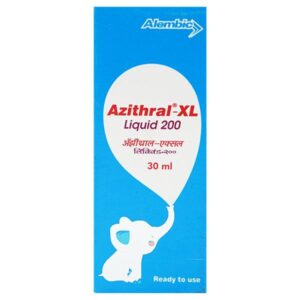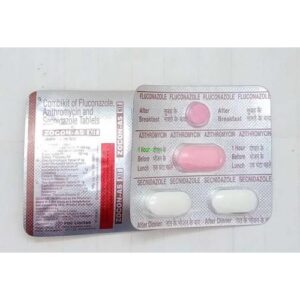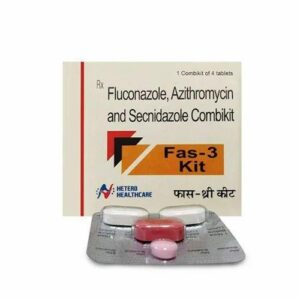FLUCONAZOLE + AZITHROMYCIN + SECNIDAZOLE
Fluconazole: Fluconazole is an antifungal medication used to treat and prevent various fungal infections. It belongs to a class of drugs called triazole antifungals.
The primary use of fluconazole is to treat fungal infections caused by Candida species. It is effective against infections in different body parts, including the mouth, throat, esophagus, lungs, bladder, genital area, and bloodstream. Fluconazole can also be used to prevent fungal infections in individuals with weakened immune systems, such as those undergoing chemotherapy or organ transplantation.
The mechanism of action of fluconazole involves inhibiting the growth and replication of fungal cells by targeting a specific enzyme, lanosterol 14-alpha-demethylase. This enzyme is essential for the synthesis of ergosterol, a key component of the fungal cell membrane. By inhibiting this enzyme, fluconazole disrupts the integrity of the fungal cell membrane, leading to cell death.
The dosage of fluconazole depends on the type and severity of the infection. It is available in various forms, including oral tablets, oral suspension, and intravenous infusion. For most infections, the typical adult dose is a single 150 mg oral tablet. In more severe cases or systemic infections, a loading dose of 200-800 mg may be given, followed by a maintenance dose.
Some common side effects of fluconazole include nausea, headache, abdominal pain, diarrhea, and dizziness. Rarer, but more serious side effects may include liver toxicity, allergic reactions, and changes in heart rhythm. It is important to inform a healthcare provider about any existing medical conditions or medications being taken, as fluconazole can interact with certain drugs.
As with any medication, it is essential to follow the prescribed dosage and duration of treatment. If side effects occur or the infection does not improve, it is crucial to consult a healthcare professional for further guidance.
Azithromycin: Azithromycin is an antibiotic commonly used to treat a variety of bacterial infections. It belongs to the class of drugs known as macrolide antibiotics.
The primary use of azithromycin is for the treatment of respiratory tract infections, such as bronchitis and pneumonia, as well as ear and skin infections. It is also effective against certain sexually transmitted infections, including chlamydia and gonorrhea.
The mechanism of action of azithromycin involves inhibiting the synthesis of bacterial proteins, thereby preventing the growth and spread of the bacteria causing the infection. It works by binding to the bacterial ribosomes and interfering with the protein synthesis process.
The typical dose of azithromycin varies depending on the condition being treated and the severity of the infection. For most infections, a common dosage is a one-time 1 gram dose or a 500mg dose on the first day, followed by 250mg once daily for the remaining 4 days. For some sexually transmitted infections, a single 1 gram dose is sufficient.
Azithromycin is generally well-tolerated, but like any medication, it can cause side effects. Common side effects may include diarrhea, nausea, stomach pain, vomiting, and headache. These side effects are usually mild and go away on their own. Rarely, azithromycin can cause more serious side effects, such as liver problems, allergic reactions, and an abnormal heart rhythm. It is important to seek medical attention if any severe or persistent side effects occur.
As with any antibiotic, it is important to take azithromycin as prescribed by a healthcare professional and to complete the full course of treatment, even if symptoms improve. This helps ensure that the infection is completely eradicated and reduces the risk of antibiotic resistance.
Secnidazole: Secnidazole is an oral medication that belongs to the class of drugs known as nitroimidazoles. It is primarily used to treat certain types of infections caused by protozoa, including trichomoniasis, giardiasis, and amebiasis.
The mechanism of action of secnidazole involves interfering with the DNA synthesis of the infecting parasites, thereby leading to their death. It is effective against anaerobic protozoa and bacteria by disrupting their DNA strands. This drug has a broad spectrum of activity and demonstrates excellent efficacy in eradicating the targeted organisms.
In terms of dosage, the usual recommendation for adults is a single oral dose of 2 grams (2000 mg) of secnidazole. This single-dose regimen offers convenience and high patient compliance. For children, the dosage is determined based on their body weight and is administered orally.
As with any medication, secnidazole can cause certain side effects. The most commonly reported side effects include nausea, headache, dizziness, abdominal pain, and a metallic taste in the mouth. These side effects are generally mild and transient. In rare cases, more severe side effects such as allergic reactions, seizures, or neuropathy can occur, but these are uncommon.
It is important to note that secnidazole may interact with certain medications such as warfarin and lithium, so it is necessary to consult with a healthcare professional or pharmacist before starting this medication if you are taking any other medications.
Overall, secnidazole is a well-tolerated and effective treatment for various protozoal infections. However, it is important to follow the prescribed dosage and consult a healthcare professional if you experience any concerning side effects.




